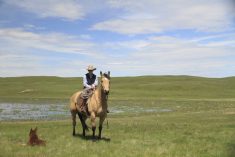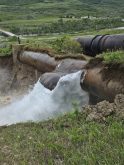You can’t manage what you don’t measure” is a refrain among agricultural producers of all stripes, and the right measurement tools usually come in the form of benchmarks.
However, there’s a shortage of benchmarks that specifically measure cost of production, so the provincial agriculture department has developed a program exclusively for Alberta farmers. It’s called AgriProfits and all Alberta beef, field crop, dairy, beekeeping and greenhouse crop producers are invited to participate.
“From the producer side, detailed cost information isn’t necessarily the most easy thing to come by and oftentimes comes from pretty disparate sources. And on top of that (they aren’t) necessarily provincial-specific or area-specific,” said Ian Ryan, senior livestock economist with the province.
Read Also

Moo translator and methane measures: There’s an app for that
Dalhousie University researchers use artificial intelligence to create new dairy farm apps that analyze cattle sounds and measure methane.
AgriProfits is about more than data, he added, and participation can create benefits that may be just as important.
“The value of the cost of production analysis is not in the figures themselves, but in gaining a better understanding of the farm business in order to pinpoint areas for improvement,” said Ryan.
“Profitability can vary widely from year to year but keeping thorough records of costs and returns can help control profitability. Each year is different and dependent on the relationships between yield, price and costs, as well as the producers’ financial situation. Proactive cost management makes businesses better able to weather periods of fluctuation.”
Although the free, confidential program is targeted to producers, Alberta Agriculture and Irrigation is also an audience for the data, said Ryan.
“This program provides us with granular and high quality empirical data, which helps with our analysis and research at the ministry.”
He described AgriProfits as a twofold program, with data collection and a farmer survey on costs of production and revenues. In return, participants receive individualized and detailed cost of production reports.
To preserve confidentiality, data from these surveys is compiled into province-wide averages and released in yearly publications dedicated to the ag sector in question. Each covers five years of data.
The benchmarks summarize all sources of income and expenses related to the type of agriculture enterprise and cover all activities related to producing the crop or herd in a given fiscal year.
For example, cost of production reports for cow-calf producers include economic performance indicators in dollars per unit of production (dollars per pound weaned and dollars per cow wintered). Physical performance indicators are presented based on breeding and feeding information as well as conception, calving, weaning and calf crop rates.
Financial performance indicators offer a snapshot of the sector’s liquidity (ability to meet financial obligations), solvency (ability to meet long-term financial obligations) and profitability (returns generated).
“There aren’t many tools or resources out there that allow producers to compare their costs on a per-unit basis to others in the industry. These reports help them do just that,” said Ryan.
“The data … can give producers who use the report an idea of certain types of costs and how their own operations are higher or lower than their peers. And this can help with optimizing management practices for better returns.”
The best ways to use the report are twofold, he said.
“One is within-a-year comparisons where producers can compare their own costs if they’ve got information on exactly how much they’re spending on certain types of expenses and compare that to their peers. They can try to find a way to perhaps economize on that.
“And then the other main use is through yearly benchmarks. It can give producers an idea of how costs are evolving through time and areas in which they might want to tweak management practices or try to hedge costs or those sorts of aspects.”
Farmers interested in completing the survey to receive an individualized breakdown of their operations can find sign-up forms on the AgriProfits website.
“There’s a short form we have producers fill out. They send that into us and we have a team of data collectors that will work individually with each producer that signs up and is willing to participate in the survey. The current program works anywhere between two and 10 hours, depending on the size and complexity of an individual producer’s operation.”
Full program information and links to reports can be found at the AgriProfits website.
















